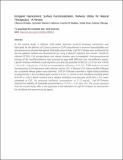| dc.contributor.author | Rubaka, Clarence | |
| dc.contributor.author | Gathirwa, Jeremiah | |
| dc.contributor.author | Malebo, Hamisi | |
| dc.contributor.author | Swai, Hulda | |
| dc.contributor.author | Hilonga, Askwar | |
| dc.date.accessioned | 2023-02-28T08:50:21Z | |
| dc.date.available | 2023-02-28T08:50:21Z | |
| dc.date.issued | 2022-08 | |
| dc.identifier.uri | https://doi.org/10.4028/p-96l963 | |
| dc.identifier.uri | https://dspace.nm-aist.ac.tz/handle/20.500.12479/1808 | |
| dc.description | This research article was published by Scientific.Net, 2022 | en_US |
| dc.description.abstract | Inorganic nanocarriers for a decade have increased interest in nanotechnology research platform as versatile drug delivery materials. The utility of the inorganic nanocarriers for delivery of therapeutic agents is attributed to their unique properties such as magnetic, photocatalytic nature and the ability to exhibit surface functionalization. Herein, we review the surface functionalization and delivery utility for natural therapeutics exhibited by inorganic nanocarriers mostly focusing on their magnetic, photocatalytic and the plasmonic properties. The review also highlights the influence of electronic property of inorganic surface on functionalization of ligand based natural therapeutic agents. Improvement of stability and therapeutic potential by formation of nanocomposites are detailed. Furthermore, we suggest improvement strategies for stability and toxicity reduction of inorganic nanoparticles that would potentially make them useful for clinical application as therapeutic delivery tools for treatment of various diseases. | en_US |
| dc.language.iso | en | en_US |
| dc.publisher | Scientific.Net | en_US |
| dc.subject | Research Subject Categories::NATURAL SCIENCES | en_US |
| dc.title | Inorganic Nanocarriers: Surface Functionalization, Delivery Utility for Natural Therapeutics - A Review | en_US |
| dc.type | Article | en_US |

